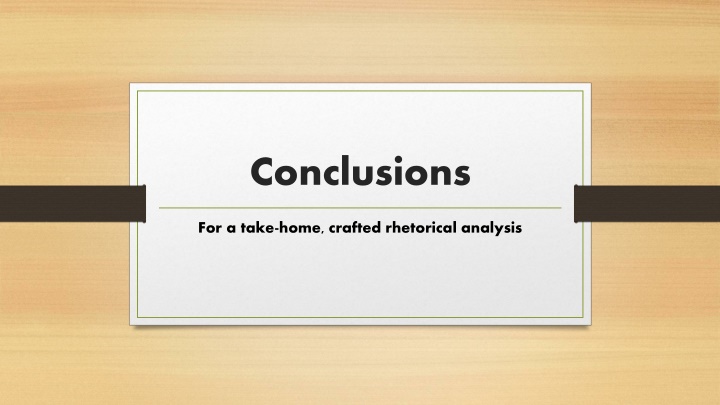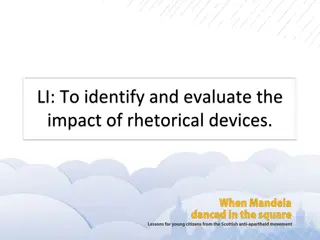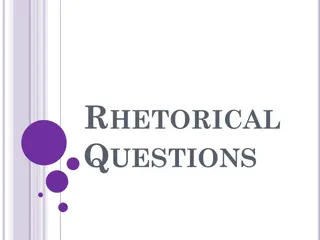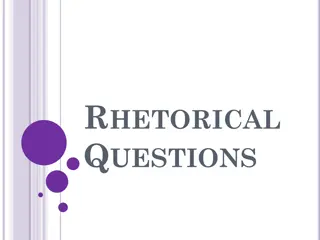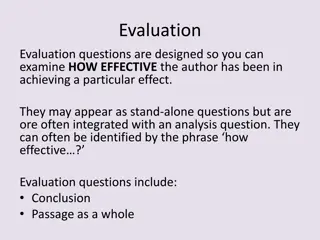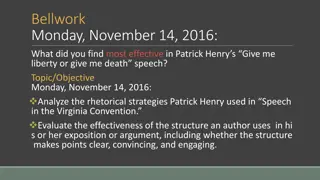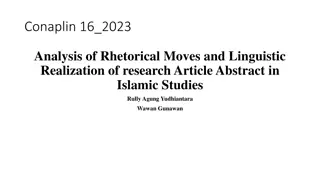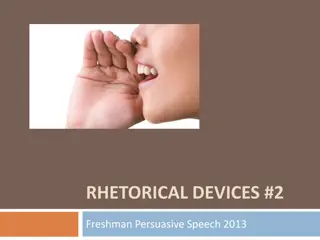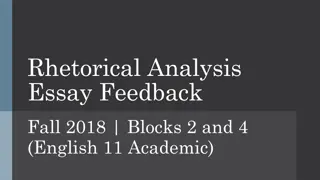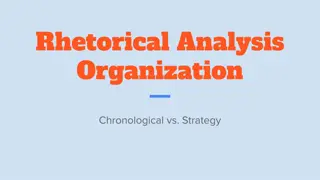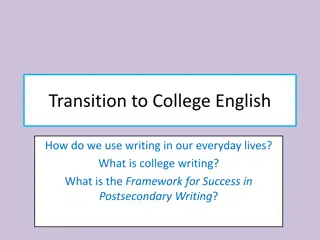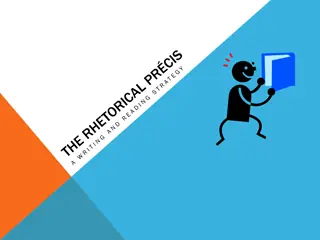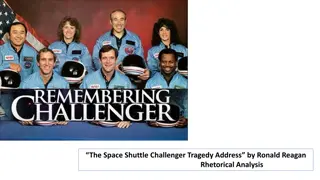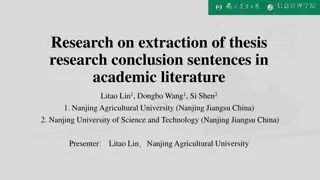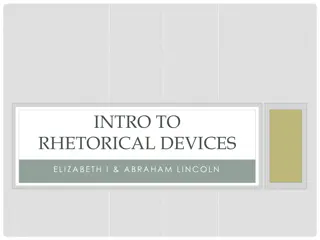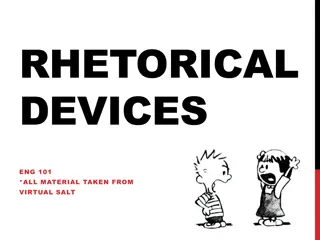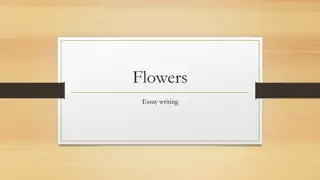Crafting an Effective Conclusion in Rhetorical Analysis
Enhance your take-home rhetorical analysis with impactful conclusions. Remember to review the thesis, main ideas, and overall significance without criticizing the writer's style. Use concise sentences to reflect on the relevance of the piece and provide predictions for the future or the impact of the topic. Consider key themes from analyzed pieces like a Chipotle commercial, MLK's activism, Toni Morrison's perspective, and JFK's legacy.
Uploaded on Sep 26, 2024 | 0 Views
Download Presentation

Please find below an Image/Link to download the presentation.
The content on the website is provided AS IS for your information and personal use only. It may not be sold, licensed, or shared on other websites without obtaining consent from the author.If you encounter any issues during the download, it is possible that the publisher has removed the file from their server.
You are allowed to download the files provided on this website for personal or commercial use, subject to the condition that they are used lawfully. All files are the property of their respective owners.
The content on the website is provided AS IS for your information and personal use only. It may not be sold, licensed, or shared on other websites without obtaining consent from the author.
E N D
Presentation Transcript
Conclusions For a take-home, crafted rhetorical analysis
Quick note: timed essays If, on the AP exam, you find that you are running out of time, WRITE A CONCLUSION, even if it s just a sentence; then you at least demonstrate that you understand proper format and that you just ran out of time Otherwise, 2-4 sentences will suffice on the exam
Conclusion reminders Review the thesis not the same words as in intro Review main ideas (whether in the re-worded thesis or in separate sentences but be brief) Consider overall significance (in any one of these areas, not all!): How/why does the piece matter? (To whom? At the time? Now?) How/why does the topic matter? (To whom? At the time? Now?) Consider either prediction for the future of the topic/speaker or the impact of the speech/a main idea in it/speaker Avoid judgment of writer s style (Ex: Selby s syntax is effective and his message superior that s so contrived.)
Recall the pieces weve examined and potential ideas for a so what after writing a paper on any one of them Chipotle commercial: 2/3 of Americans are obese, ppl. don t have time to cook at home, so many are concerned about healthy eating MLK: Black Lives Matter, recent issues with blackface (Va. Governor Northrup, Megyn Kelly on air asking what s wrong with it), debate over removal of Confederate monuments, voter suppression allegations Toni Morrison: argued against selecting a candidate based on age, race, gender, etc. What would she say now about polarization driving people to select based ONLY on party or a single issue? YOU TRY: JFK
Conclusion Sample Constructing his speech with point of view shifts, pop culture allusion, and informal diction, Nicholas Selby works to compel student engagement in higher education. At such a crossroads in their lives, the students face important attitudinal decisions about their approach to college now that they find themselves physically there. In only his second year of studies, Selby serves as a model of the power of those choices, which he relates through his collective and singular points of view. Similarly, the appeal of not only future success but a culturally relevant experience through both pop culture allusion and conversational diction attempt to guide students towards the decision to seek success. As the cost of post-secondary education increases and the need for a workforce versed in sciences and technology expands, students must understand the import of the steps they take at the start of their education to transition them to the working world. A lucrative job in STEM can help students pay off college debt while also providing opportunities in careers that foster innovation. With the help of Selby s convocation speech, students are encouraged to exceed expectations and have fun doing so.
From the Abigail Adams prompt/student essay sample: ideas like women s suffrage almost a century before the rest of the nation listened, she employed language to influence her son. By resting on her authority as a mother and using language techniques to offer advice while asserting her correctness, she was able to craft letters that the men of the Adams family could not disregard. Her appeals to her authority as well as ethics proved to be a purposeful combination that allowed her to assert her voice before other women could. John Quincy must have followed her advice as he went on to become a president and statesman like his father. Just as Abigail Adams would persuade her husband to support
SAMPLE (adapted from a student conclusion on David Camerons Scotland speech) To convince the audience to remain integrated with the United Kingdom, England s Prime Minister David Cameron addressed the Scottish public prior to the referendum. Within his speech, he implements anaphora to warn of the consequences of separation while recognizing the changes necessary to keep Scotland satisfied. Additionally, first person collective point of view encourages the audience to hold in high-esteem their common history. Cameron also utilizes imperatives to urge the Scots to remain proud to be united and to save their splintering nation. Tallied ballots revealed the decision to remain a part of Great Britain for a stronger nation and future. However, with the more recent Brexit vote in which England chose to secede from the European Union, Scotland s position of unity comes into question. Cameron even resigned his position as a result of the split. Similarly, as the contentious debate over admitting refugees, especially those from Syria, explodes across the West, the cohesion of the UK may be further challenged as more countries seem to be inclined toward isolationism. While Cameron succeeded in guiding the Scottish vote to stay, his vision of a solid nation may just fragment after all.
Quick Edit Read your partner s paper Is the thesis reviewed (in words different from those employed in the introduction)? Are transitions employed? Is there some element of a so what or prediction or impact? Also, do a style check: no word jails or contractions Note any need for variety in diction or syntax
